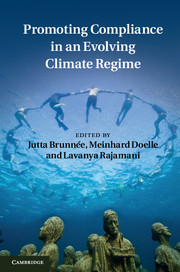Book contents
- Frontmatter
- Contents
- Contributors
- Preface
- Abbreviations
- Introduction: The role of compliance in an evolving climate regime
- Part I Context
- Part II The Kyoto compliance system: Features and experience
- Part III Compliance and the climate regime: Issues, options, and challenges
- Part IV A look forward
- Conclusion
- Bibliography
- Index
Conclusion
promoting compliance in an evolving climate regime
Published online by Cambridge University Press: 05 January 2012
- Frontmatter
- Contents
- Contributors
- Preface
- Abbreviations
- Introduction: The role of compliance in an evolving climate regime
- Part I Context
- Part II The Kyoto compliance system: Features and experience
- Part III Compliance and the climate regime: Issues, options, and challenges
- Part IV A look forward
- Conclusion
- Bibliography
- Index
Summary
Introduction
Much theoretical debate and effort in practice has been devoted to the question how best to promote compliance with multilateral environmental agreements (MEAs). At the theoretical level, it seems fair to say that no compliance theory can claim universal validity. Indeed, the experience gained with MEA compliance systems over the last fifteen years or so makes clear that a range of approaches, both facilitative and enforcement-oriented, must be harnessed. Perhaps most importantly, for a compliance system to be effective, it has to be designed with the context and particular characteristics of a specific MEA in mind. The design parameters include the substance of the MEA, the parties involved, the past experience, and the political context within which the compliance system is negotiated.
The climate change regime is no exception. As it stands at the moment, the regime boasts one of the most elaborate and multifaceted compliance systems in any MEA. Under the convention, parties have extensive monitoring and reporting obligations. The United Nations Framework Convention on Climate Change (FCCC) also provides for a facilitative compliance assessment process, the multilateral consultative process. However, due to the negotiation of the Kyoto Protocol, this process was never activated. The Kyoto parties negotiated additional inventory and reporting commitments, along with an expert review process and procedures and mechanisms relating to compliance. The procedures and mechanisms, which have been in operation since 2006, feature a facilitative stream and an enforcement stream. This compliance system was developed with the particular features of the climate regime, as well as the context in which it operates, very much in mind. For example, the compliance system distinguishes between legally soft, procedural, and policy-oriented commitments and hard, target-related commitments. For the latter, the Kyoto Protocol’s compliance procedures and mechanisms provide an enforcement-oriented approach, intended to help level the competitive playing field among parties with onerous emission reduction commitments. The enforcement branch (EB) of the compliance procedure is also designed to help ensure the functioning of the Kyoto Protocol’s emissions trading mechanisms, a unique feature of the regime,
- Type
- Chapter
- Information
- Promoting Compliance in an Evolving Climate Regime , pp. 437 - 458Publisher: Cambridge University PressPrint publication year: 2011



